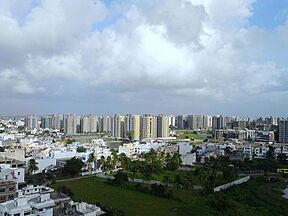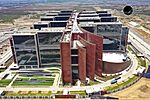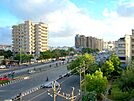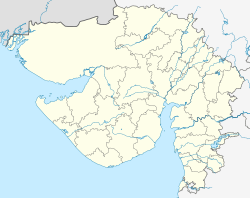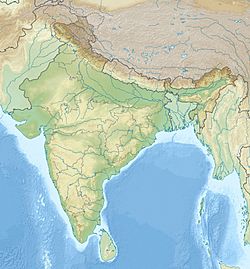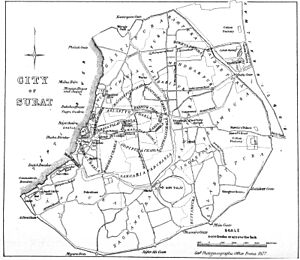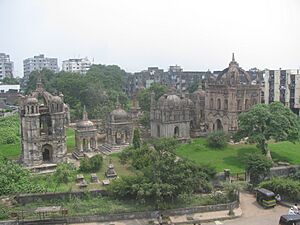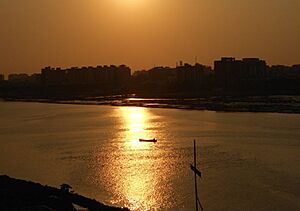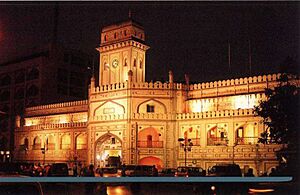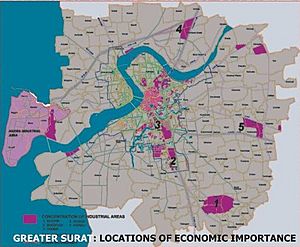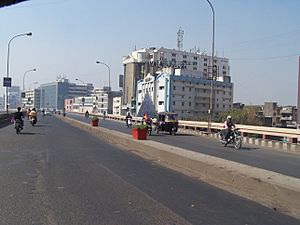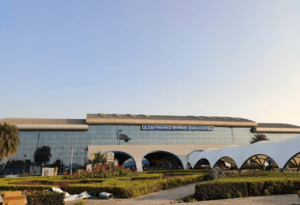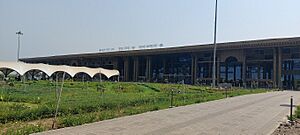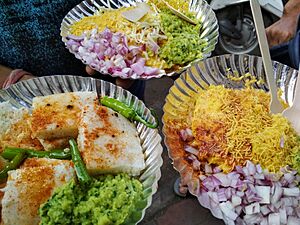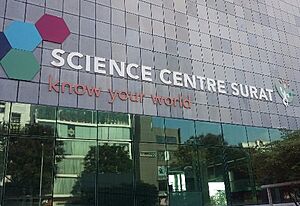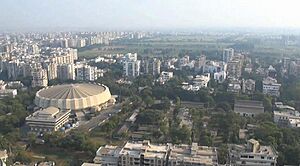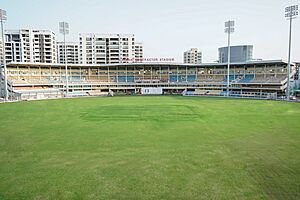Surat facts for kids
Quick facts for kids
Surat
|
|
|---|---|
|
From top: Tapi River panorama, Surat Diamond Bourse, Gaurav path, University Road, Swaminarayan Mandir, Pandit Deendayal Upadhyay Indoor Stadium, Vesu Skyline, Science Centre, Surat, Surat Airport
|
|
| Nickname(s):
Diamond City of India
|
|
| Country | |
| State | Gujarat |
| District | Surat |
| Zone | 7 |
| Named for | Surya |
| Government | |
| • Type | Mayor–Council |
| • Body |
|
| Area | |
| • Metropolis | 461.60 km2 (178.22 sq mi) |
| • Metro | 722 km2 (279 sq mi) |
| Elevation | 34.68 m (113.78 ft) |
| Population
(2021)
|
|
| • Metropolis | 6,936,534 |
| • Rank | 2nd in Gujarat |
| • Density | 15,027.15/km2 (38,920.1/sq mi) |
| • Metro rank | 9th |
| • Demonym | Surati |
| Time zone | UTC+5:30 (IST) |
| Pincode(s) |
394xxx, 395xxx
|
| Area code(s) | 0261 |
| Vehicle registration | GJ-05, GJ-19, GJ-28 |
| Sex ratio | 1.27 ♂/♀ |
| Coastline | 35 km (22 mi) |
| Language | Gujarati |
| Literacy rate | 86.65% |
| Gross domestic product | $60 billion |
| Website | https://surat.nic.in/ |
Surat is a big city in the western Indian state of Gujarat. The name Surat means face in languages like Urdu, Gujarati, and Hindi. It sits on the banks of the Tapi River, close to the Arabian Sea. Long ago, it was a very important seaport.
Today, Surat is a major business and money center for South Gujarat. It is one of the biggest urban areas in western India. The city is famous for its diamond and textile industries. About 90% of the world's diamonds are cut and polished here! Surat is the second largest city in Gujarat, after Ahmedabad. It is also one of the largest cities in India by population. Surat is the main city of the Surat district.
The city is about 284 km (176 mi) south of Gandhinagar, the state capital. It is also 265 km (165 mi) south of Ahmedabad and 289 km (180 mi) north of Mumbai. The heart of the city is right on the Tapi River.
Surat is expected to be the world's fastest-growing city from 2019 to 2035. This was found in a study by the Economic Times. The city's economy grew very fast between 2001 and 2008. Surat was named the "best city" in a survey in 2013. It was also chosen as India's first smart IT city. This project is a partnership between Microsoft CityNext and big IT companies like Tata Consultancy Services and Wipro. Many people in Surat use the internet, about 65% of everyone living there. In 2015, Surat received a grant from IBM Smarter Cities Challenge. It is also one of twenty Indian cities becoming a smart city under PM Narendra Modi's plan. Surat is home to the Surat Diamond Bourse, which is the world's largest office building by size.
Surat has also worked hard on cleanliness. It was ranked as the second cleanest city in India in 2020. Even though its ranking changed in later years, Surat keeps working on being clean. In 2023, it shared the title of the cleanest city in India with Indore. This shows its ongoing efforts to stay clean.
Contents
History of Surat
How Surat Got Its Name
People often say that a rich merchant named Gopi built Surat around the year 1500. At first, the town had no name. It was just called "the new place." Gopi asked astrologers for a name. They suggested "Suraj" or "Suryapur," meaning "city of the sun." Gopi asked the king of Gujarat to name the town this. But the Muslim king changed it to Surat. He named it after the word surah, which are chapters in the Qur'an. However, both "Suryapur" and "Surat" were mentioned before 1500. So, the city and its name are older than Gopi's time.
Duarte Barbosa called Surat "Suratt." Jacob Peeters called it "Sourratte," which is a Dutch name. Surat has had many names throughout history. It is also known as Surrat, Surate, or Soorat in some old writings.
Early History of Surat
Before Surat became famous in the 1500s, a nearby town called Rander was the main trading spot. Rander had many Arab merchants who traded with places like Burma, China, and Sumatra. In the 1500s, Portuguese attacks caused Rander to decline. Surat then grew into an important port city. Many merchants from Rander probably moved to Surat for better business.
Surat is mentioned in old writings from the 10th century. But these writings don't say much about the town. As Suryapur, it was mentioned in 990 when an army passed through it. This army was going to attack the ruler of Lata. Some historians think Suryapur might be the port "Surabaya" mentioned by an Arabic geographer. But it's not certain if this was a big town or just a small village.
Surat is also mentioned in the 1190s. This was after Qutb ud-Din Aibak defeated the Chaulukya king. Aibak reached Rander and Surat. Surat was then ruled by a Hindu chief from Kamrej. This chief gave up to Aibak, who let him continue ruling Kamrej.
From 1297, Allauddin Khilji, the ruler of the Delhi Sultanate, slowly took over Gujarat. The Delhi Sultanate appointed governors to control Gujarat. But this control was not always easy. In 1347, Muhammad bin Tughluq attacked Surat. Later, Firoz Shah Tughlaq built a fort in Surat in 1373. At this time, Surat was not very crowded.
By the end of the 14th century, the Delhi Sultanate's power weakened. Gujarat became independent in 1407. Surat was controlled by nobles from the Rajput kingdom of Baglana. Later, after 1538, local nobles like Chengiz Khan ruled Surat. But in 1637, Aurangzeb made Baglana part of the Mughal Empire.
In 1514, a Portuguese traveler named Duarte Barbosa said Surat was a key seaport. Many ships from different parts of the world visited it. By 1520, the city was called Surat. The Portuguese burned it twice (in 1512 and 1530). The Mughals took it over in 1573. The Maratha king Shivaji attacked it twice in the 17th century. Mughal Emperor Akbar saw Gujarat as very important. He launched two big campaigns against Gujarat in the 1570s. Surat fell during one of these campaigns. It took one month and seventeen days to conquer. Taking Surat was very important for trade during the Mughal Empire. It became the most important port city and a busy trading center.
Surat During the Mughal Empire
Surat was the richest port in the Mughal Empire. Even though it was rich, Surat looked like a typical trading town. It had mud-and-bamboo houses and winding streets. But along the river, there were some grand houses and warehouses. These belonged to local rich merchants and traders from Turkey, Armenia, England, France, and Holland. There were also hospitals for animals run by Jains, which surprised travelers. Some streets were narrow, while others were wide. In the evenings, especially near the market, the streets were full of people and merchants selling goods. Surat had many people during the Mughal era. But many people were also just visiting. During the monsoon season, when ships could safely come and go, the city's population grew a lot.
In 1612, England set up its first Indian trading factory in Surat. The Maratha king Shivaji attacked the city twice. The first attack was in 1664. Shivaji's raids scared away trade and harmed the city.
Later, Surat became a major trading center for India. It exported gold and cloth. Its main industries were shipbuilding and making textiles. The coast of the Tapti River was used for shipbuilding. The city stayed rich until Mumbai grew bigger. After that, Surat's shipbuilding industry declined. Surat itself slowly declined throughout the 18th century. In 1790–1791, a disease killed 100,000 people in Surat. Both the British and Dutch wanted control of the city. But in 1800, the British took control. A big fire in 1837 killed over 500 people and destroyed much of the city.
By the mid-1800s, Surat was a quiet city with about 80,000 people. When India's railways started, the city began to grow rich again. Silks, cotton, fancy fabrics, and items made of gold and silver from Surat became famous. The old art of making fine muslin cloth was also brought back.
Surat Under British Rule
Under British Raj, Surat became less important than it was during the Mughal Empire. It was still a key city for textiles. But for the British, it was not as important as a port city. Still, Surat traded a lot with Asia and Europe. It traded with both Europeans and Armenian merchants.
Surat focused on trading things that did not compete with European products, like pearls and silver. The textile industry was also a big part of Surat’s shipping success. But Surat usually did not make these textiles locally. Gold and silver were also very important to Surat’s economy. A British traveler named John Ovington visited Surat. He noted the city's great wealth in gold and silver. He also saw "abundance of Pearls" and other precious stones like diamonds. These could be bought at "very reasonable rates." This industry was vital for Surat's success under British rule. It helped the city stay important as a port.
During Mahatma Gandhi's Quit India Movement in 1942, many Koli farmers fought British soldiers. This happened in Matwad, near Surat, on August 21, 1942. Four people died in this fight, including one policeman. The Kolis also took police guns and bayonets. They damaged the Jalalpore Railway Station. They removed rails and burned down the post office. After this, the situation in nearby villages became very tense. British troops had to march through the villages from August 22 to 24, 1942.
Armenians in Surat
The Armenian community in Surat was very active from the 16th to the 17th centuries. They left a big mark on the city's history. The Armenian gravestones in Surat are old and well-kept. They show the community's presence and traditions.
Armenians in Surat were famous traders. They traded in jewelry, precious stones, cotton, and silk. They set up trade routes to places like Egypt, Turkey, and Venice. They often traveled with their families.
The British knew how good Armenians were at business. They wanted to work with them to get trading rights in the Mughal court. Today, these gravestones remind us of the Armenian community's important role in Surat's past.
Modern Period in Surat
After India's Independence
After India became independent on August 15, 1947, Surat became part of India. At first, it was part of Bombay State. Later, it became part of Gujarat state. Surat grew quickly, like Mumbai and Ahmedabad. It became a major business and industrial center in Western India. After independence, Surat's industries grew a lot. Especially the textile and chemical industries, along with trading.
The 1994 Cleanliness Drive
In 1994, Surat faced a big challenge related to public health. There were reports of a health issue, and many people left the city. About a quarter of Surat’s population moved away. This situation highlighted the need for better city management.
The city's leaders decided to take strong action. Suryadevara Ramachandra Rao became the new administrator. He started big cleaning campaigns. These campaigns included checking hotels and shops to make sure they were handling garbage properly. He also made sure roads were widened and that the city was swept regularly. Garbage collection became a routine. Many unauthorized buildings were removed. When streets were widened, residents whose homes were affected were given new places to live with good facilities. These actions helped Surat recover and become much cleaner.
This event brought attention to the importance of cleanliness and accurate information. Surat's efforts led to the Indian National Trust for Art and Cultural Heritage calling it the second cleanest city in India.
Surat Today
On October 2, 2007, Surat district was divided into two. A new Tapi district was created. This was done under the Surat District Re-organisation Act 2007.
Geography of Surat
Surat is a port city located on the banks of the Tapi river. After dams were built, the river's water flow decreased. This caused the old port facilities to close. The closest ports are now in the Magadalla and Hazira areas. Surat has a famous beach called 'Dumas Beach' in Dumas. The city is located at 21°12′18″N 72°50′24″E / 21.205°N 72.840°E. Its average height above sea level is 13 meters. The Surat district is surrounded by other districts like Bharuch and Navsari. To the west is the Gulf of Cambay. The climate is tropical, and there is a lot of rain during monsoon season. The city is in seismic zone-III, which means it has a moderate risk of earthquakes.
Climate and Weather
Surat has a tropical savanna climate. This climate is greatly affected by the sea and the Gulf of Camboy. Summer starts in early March and lasts until June. April and May are the hottest months. The average high temperature is about 37 °C (99 °F). The Monsoon season begins in late June. The city gets about 1,200 mm (47 in) of rain by the end of September. The average high temperature during these months is 32 °C (90 °F). October and November see the end of the monsoon. High temperatures return until late November. Winter starts in December and ends in late February. Average temperatures are around 23 °C (73 °F), and there is very little rain.
Since the 1900s, Surat has had about 20 floods. In 1968, most of the city was flooded. In 1998, 30 percent of Surat was underwater. This was because of flooding in the Tapi river after water was released from the Ukai Dam. In August 2006, over 95 percent of the city was under Tapi river waters. This flood killed more than 120 people. Tens of thousands were stuck in their homes without food or electricity. Businesses and schools were closed for weeks. Surat expects more flooding and extreme weather as climate change gets worse. So, the city has invested in flood protection and ways to deal with climate changes.
| Climate data for Surat (1991–2020, extremes 1877–2012) | |||||||||||||
|---|---|---|---|---|---|---|---|---|---|---|---|---|---|
| Month | Jan | Feb | Mar | Apr | May | Jun | Jul | Aug | Sep | Oct | Nov | Dec | Year |
| Record high °C (°F) | 38.3 (100.9) |
41.7 (107.1) |
44.0 (111.2) |
45.6 (114.1) |
45.6 (114.1) |
45.6 (114.1) |
38.9 (102.0) |
37.2 (99.0) |
41.1 (106.0) |
41.4 (106.5) |
39.4 (102.9) |
38.9 (102.0) |
45.6 (114.1) |
| Mean daily maximum °C (°F) | 30.2 (86.4) |
32.2 (90.0) |
35.4 (95.7) |
36.6 (97.9) |
35.7 (96.3) |
33.8 (92.8) |
31.1 (88.0) |
30.8 (87.4) |
32.0 (89.6) |
34.9 (94.8) |
34.1 (93.4) |
31.6 (88.9) |
33.2 (91.8) |
| Daily mean °C (°F) | 22.6 (72.7) |
24.7 (76.5) |
28.0 (82.4) |
30.3 (86.5) |
31.4 (88.5) |
30.3 (86.5) |
28.7 (83.7) |
28.1 (82.6) |
28.6 (83.5) |
29.0 (84.2) |
26.8 (80.2) |
23.7 (74.7) |
27.7 (81.8) |
| Mean daily minimum °C (°F) | 15.2 (59.4) |
17.2 (63.0) |
20.9 (69.6) |
24.4 (75.9) |
27.4 (81.3) |
27.3 (81.1) |
26.2 (79.2) |
25.9 (78.6) |
25.6 (78.1) |
23.5 (74.3) |
19.9 (67.8) |
16.6 (61.9) |
22.5 (72.5) |
| Record low °C (°F) | 4.4 (39.9) |
5.6 (42.1) |
8.9 (48.0) |
15.0 (59.0) |
19.4 (66.9) |
20.2 (68.4) |
19.9 (67.8) |
20.2 (68.4) |
20.6 (69.1) |
14.4 (57.9) |
10.6 (51.1) |
6.7 (44.1) |
4.4 (39.9) |
| Average rainfall mm (inches) | 1.9 (0.07) |
0.3 (0.01) |
0.7 (0.03) |
0.5 (0.02) |
2.4 (0.09) |
255.9 (10.07) |
466.3 (18.36) |
281.7 (11.09) |
186.7 (7.35) |
40.7 (1.60) |
5.1 (0.20) |
1.1 (0.04) |
1,243.4 (48.95) |
| Average rainy days | 0.2 | 0.1 | 0.1 | 0.1 | 0.2 | 8.0 | 15.0 | 12.3 | 8.1 | 2.0 | 0.5 | 0.1 | 46.5 |
| Average relative humidity (%) (at 17:30 IST) | 41 | 35 | 32 | 43 | 61 | 72 | 81 | 80 | 72 | 54 | 46 | 45 | 55 |
| Average dew point °C (°F) | 9 (48) |
10 (50) |
10 (50) |
14 (57) |
19 (66) |
23 (73) |
25 (77) |
25 (77) |
24 (75) |
19 (66) |
14 (57) |
11 (52) |
17 (62) |
| Average ultraviolet index | 6 | 7 | 7 | 8 | 8 | 7 | 6 | 6 | 7 | 7 | 7 | 6 | 7 |
| Source 1: India Meteorological Department Time and Date (dewpoints, 2005-2015) | |||||||||||||
| Source 2: Tokyo Climate Center (mean temperatures 1991–2020); Weather Atlas | |||||||||||||
People of Surat
| Historical population | ||
|---|---|---|
| Year | Pop. | ±% |
| 1810 | 73,000 | — |
| 1871 | 107,100 | +46.7% |
| 1881 | 109,800 | +2.5% |
| 1891 | 109,200 | −0.5% |
| 1901 | 119,300 | +9.2% |
| 1911 | 114,900 | −3.7% |
| 1921 | 117,400 | +2.2% |
| 1931 | 98,900 | −15.8% |
| 1941 | 171,400 | +73.3% |
| 1951 | 223,200 | +30.2% |
| 1961 | 288,000 | +29.0% |
| 1968 | 368,900 | +28.1% |
| 1971 | 492,700 | +33.6% |
| 1981 | 912,600 | +85.2% |
| 1991 | 1,519,000 | +66.4% |
| 2001 | 2,811,614 | +85.1% |
| 2011 | 4,591,246 | +63.3% |
| 2013 | 5,300,000 | +15.4% |
Someone who lives in Surat is called a Surati. In 2011, Surat had a population of about 4.4 million people. Surat has a high literacy rate of 89%. This is higher than the national average of 79.5%. For males, literacy is 93%, and for females, it is 84%. Males make up 53% of the population, and females make up 47%. About 13% of the people in Surat are under 6 years old.
Religions in Surat
| Religion in Surat City (2011) | ||||
|---|---|---|---|---|
| Hinduism | 85.31% | |||
| Islam | 11.63% | |||
| Jainism | 2.31% | |||
| Others/not stated | 0.76% | |||
Most people in Surat follow Hinduism. A significant number of people also follow Islam. There is also a notable community of Jainism followers. Other religions are also present in smaller numbers.
City Management and Safety
The Surat Municipal Corporation (SMC) manages the city's services. This includes roads, water, and other public needs. The BJP is currently the main ruling party in the SMC. The SMC follows rules from the Bombay Provincial Municipal Corporations Act of 1949. Power is shared among the General Board, Standing Committee, and Municipal Commissioner. In 2014, Surat was ranked 7th among 21 Indian cities for its good management. It is the only city in India that shares its city budget details every week.
Keeping Surat Safe
Surat started the 'Safe City Project' in 2011. Its goal is to keep the city safe using surveillance cameras. Sanjay Srivastava, a police officer, led this project. A very large video screen is in the Police Commissioner's control room. This screen helps the police watch the whole city live. They use 10,000 CCTV cameras placed around the city. Surat police plan to install 5,000 more CCTV cameras in important spots. Some will be night vision cameras. This project is a team effort. It involves city businesses, social groups, the Surat Municipal Corporation, and the Surat City Police.
Hospitals in Surat
Surat has several important hospitals and medical colleges:
- Government Medical College
- Surat Municipal Institute of Medical Education and Research
- Kiran Hospital
Economy of Surat
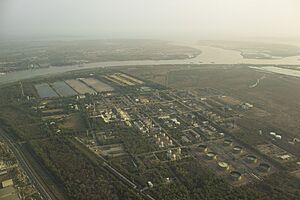
Surat was ranked 9th in India for its economy in 2016. Its economy was about $40 billion. By 2020, it was estimated to be around $57 billion. Surat is a major center for cutting and polishing diamonds. The first diamond workshops in Gujarat started in Surat and Navasari in the late 1950s. Many people from the Saurashtra region of Gujarat work in this industry. Because of high demand, Surat's diamond industry grew a lot from the 1970s to the 1980s. Today, most diamond polishing workshops are in the Varachha area of Surat. People from the Patel community mostly run them. Around the world, 8 out of 10 diamonds are cut and polished in Surat. This industry brings India about US$10 billion in exports each year.
Surat is also known as the textile hub of India or the Silk City of India. It is famous for its cotton mills and Surat Zari Craft. Surat is the biggest center for man-made fibers in India. It has many dyeing and printing mills and power loom units. There are over a hundred thousand units and mills in total. The total yearly business is about 5 billion rupees. There are over 800 cloth wholesalers in Surat. It is the largest maker of clothes in India. You can find Surti dress material in any state of India. Surat makes 9 million meters of fabric every year. This is 60% of all polyester cloth made in India. Now, the city wants to export even more of its textiles.
Many small and medium-sized IT companies are in Surat. Big IT companies like IBM and HCL also have offices here. In 2014, the Government of Gujarat set up STPI Surat. The city wants an information technology (IT) hub and an Indian Institute of Information Technology (IIIT). Microsoft has partnered with Tata Consultancy Services and Wipro for its CityNext initiative in Surat. This project uses technology for the city's growth. In 2011, Surat hosted India's first Microsoft DreamSpark Yatra, a tech event. In 2015, IBM chose Surat for its smart cities program. This program helps cities with things like waste management and citizen services.
As a port city, Surat has become a major business and industrial center. It is home to many big companies. These include Oil and Natural Gas Corporation, Reliance Industries, Essar Steel, and Larsen & Toubro. The Hazira Port is in Hazira, an industrial area where many industries are located. The Port of Magdalla is also being developed.
The government of Gujarat plans another big project near Surat. It will be similar to Gujarat International Finance Tec-City (GIFT). The Chief Minister wants to build a new area called DREAM. It will have hotels, banks, IT offices, trading houses, and entertainment zones. The Surat Diamond Bourse (SDB) will be based there. The land for this project is easy for the state government to use. The Trade Centre, near Sarsana village, will have a very large hall.
Transport in Surat
The Surat railway station was built in 1860. It is managed by the Western Railway zone. In 2016, it was named the best large station in India for cleanliness.
The Sitilink or Surat BRTS is a fast bus system in the city. It was started by Bharat Shah. The Surat Municipal Corporation runs it. As of August 2017, it had 245 buses connecting major parts of the city.
Surat International Airport is in Magdalla, about 11 kilometers (7 mi) southwest of Surat. It is the second busiest airport in Gujarat. Many airlines offer flights from Surat to major cities in India. There are also regular international flights to Sharjah. The airport also serves nearby areas like Navsari and Valsad.
Surat Metro is a new rail system being built for the city.
Culture of Surat
Food in Surat
Surat is famous for its food, especially its street foods. There is a popular saying in Gujarati: "સુરતનું જમણ અને કાશીનું મરણ." This means, "Eat in Surat and Die in Kashi" for the best experience.
Some unique dishes from Surat include Locho, Ghari (sweet), Surti Bhusu, Alupuri, Kavsa, Ponk, Ulta Vadapav, Undhiyu, Dhokla, Khaman, Rasaawala Khaman, and Sev Khamani.
People in Surat love food so much that there is a lane called "Khaudra Gali." This means "foodie's lane." It has many food stalls with different kinds of dishes. The Mysore Dosa is a special dish found there.
Education in Surat
Universities and Colleges
Sardar Vallabhbhai National Institute of Technology, Surat is one of India's top engineering schools. It is recognized as an important national institution. The Indian Institute of Information Technology, Surat started in 2017.
Most local colleges are connected to Veer Narmad South Gujarat University (VNSGU). This university is named after the poet Veer Narmad. Its main office is in the Surat Metropolitan Region. Colleges are also linked to SNDT and Gujarat Technological University. Government Medical College, Surat is a medical school over 50 years old. It admits 250 students each year and has a large hospital. Surat Municipal Institute of Medical Education and Research (SMIMER) is another medical college. Auro University also offers education in Surat.
Science Centre Surat
The Science Centre, Surat, is a large complex built by the Surat Municipal Corporation in 2009. It was the first of its kind in western India. The complex has a science center, a museum, an art gallery, an auditorium, an amphitheater, and a planetarium.
Sports in Surat
Pandit Dindayal Upadhyay Indoor Stadium
The Pandit Dindayal Upadhyay Indoor Stadium can seat 6800 people. It is the first stadium of its kind in Western India. The stadium often hosts national and international indoor games. These include volleyball, table tennis, gymnastics, handball, boxing, wrestling, badminton, basketball, and tennis. It has a large central area and rooms for players and officials. It also has snack bars. This stadium is also used for cultural events, music concerts, plays, fashion shows, and conferences. In 2018, it hosted TEDxSurat, which was the biggest TEDx conference in Gujarat.
Lalbhai Contractor Cricket Stadium
The Lalbhai Contractor Cricket Stadium can hold over 7000 people. It has hosted many important cricket matches. These include Ranji, Irani, and Duleep Trophy matches. The stadium is also a main place for young cricketers and fans. It has hosted special matches for international cricketers too.
Surat in Books
- The Coffee-House of Surat — by Leo Tolstoy
- A Voyage to Surat in the Year 1689 — by John Ovington
- The Land of Malabar — by Duarte Barbosa
Neighborhoods and Areas
- Bhimrad
- Kosamba
- Varachha
- Udhana
- Sachin
- Pandesara
- Athwalines
Famous People from Surat
- Abbas–Mustan, Bollywood directors
- Hashim Amla, South African Cricketer
- Prachi Desai, actress in Bollywood
- Govind Dholakia, Indian businessman
- Savji Dholakia, Indian businessman
- Pratik Gandhi, Bollywood actor
- Sanjeev Kumar (Haribhai Jariwala), film actor
- Narmad, Gujarati poet and reformer
- Hardik Pandya, Indian international Cricketer
- Laljibhai Patel, Indian diamond businessman
- Mufaddal Saifuddin religious leader
- Harsh Sanghavi, politician
- Gunvant Shah, educationist and writer
- Farooq Sheikh, actor and TV presenter
- Abid Surti, Indian cartoonist and writer
- Mehul Surti, Indian musician
- Rusi Surti, Indian cricketer
- Naval Tata, former chairman of Tata Group
- Virji Vora, famous businessman
See also
 In Spanish: Surat para niños
In Spanish: Surat para niños


